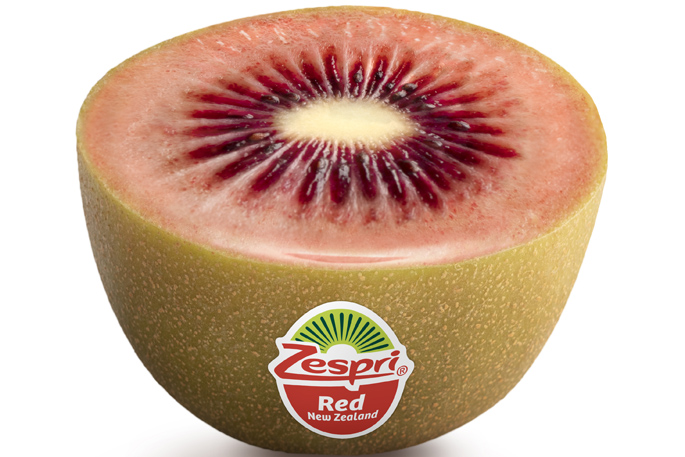The commercial release of Zespri’s red kiwifruit is being greeted with cautious excitement by many in the industry, including Doug Brown, chairman of New Zealand Kiwifruit Growers Inc.
“This is a new export opportunity for growers and the markets are really excited about a Zespri Red so demand is likely to be high.
“Of course, we have to temper that by recognising that this is a new variety and is not without risk.”
Doug says the variety “is not a red G3” – the highly successful Zespri gold kiwifruit marketed as SunGold.
“Growers will need to do due diligence before making a commitment to grow Zespri Red, but that is not to take anything away from the opportunity this variety offers.”
NZKGI recognises the advantages of broadening the portfolio of varieties through the release of a red kiwifruit variety. Such diversification can support the industry gaining shelf space in supermarkets.
“We want to see as many growers as possible have the opportunity to grow this new variety, but they must go into it with their eyes open. Initially, 150ha of licence will be released but more are likely to follow so this will not be the last chance to grow red,” says Doug.
Buzz in markets
Zespri’s chief grower and alliance officer Dave Courtney says the announcement in early-December that Zespri would commercialise a red kiwifruit created an immediate buzz in the markets.
“Growers, consumers and our customers have been waiting for a Zespri Red for a long time.”
Zespri and Plant & Food, which bred the new variety using conventional breeding techniques, experienced a setback in the breeding programme when the vine disease Psa-V wiped out most of the promising red varieties in 2010.
“So we had to start again. We have a rigorous process new varieties go through before commercial release and that takes time.”
Zespri plans to release 150ha of Zespri Red for tender by New Zealand growers this year. That figure reflects the small amount of budwood currently available, says Dave.
The cost of licences will largely be decided by growers. “Growers will take into account the risks involved with a new variety and the per ha returns when they decide what price to tender.”
Zespri expects returns for red to be around $100,000 per ha once vines reach full production in 2025, but Dave says that’s an indicative figure only and more financial information will be available when tender documents are released around March.
More to be learned
In trials the red has performed well both on its own rootstock and when grafted to existing rootstock. It hasn’t been trialled in all of the growing regions, but Dave says there is nothing so far to indicate it won’t do well where other kiwifruit is grown. Zespri also intends to conduct growing trials of the fruit in the Northern Hemisphere.
While the variety has been closely scrutinised during its pre-commercial release period, Dave says there is undoubtably more to be learned.
“I am continually impressed at the innovation within the industry and many growers are keen to get their hands on this red and learn what they can about it.”
There will be support for growers who take up licences including access to the robust science behind its development, technical transfer and field days. Dave says a strength of the New Zealand industry is the willingness of all involved to share their knowledge.
Zespri hopes its new red kiwifruit will attract new consumers to the category as well as existing consumers who eat green and gold as breakfast fruit but may enjoy red in the afternoon.
Apata Ltd’s managing director Stuart Weston says Zespri Red should not pose any particular problems for the post-harvest sector.
“The issue will be the time it takes to build up critical mass. Post-harvest has evolved to be a fast-paced, volume-driven industry and the red is likely to come on in bits and pieces to begin with.
“Apata has experience with handling earlier reds and has carried out pre-commercial trials on new varieties for Zespri before, so new varieties are not scary for us. This variety appears to store better than previous reds, so storage is less of a concern.”
Harvest, which begins in mid-March, does not collide with SunGold so the red slots in well to the season from a post-harvest point of view, says Stuart.
“It’s not a major game-changer but if the red helps growers with diversity of crops and an increase in wealth, that’s great.”
Do your homework
Katikati horticulturalist and post-harvest operator Hugh Moore says he will “be going red at some stage, maybe not this coming season”.
“I have seen three new varieties fail, Tomua (an early green), G9 (gold fruit) and G14 (a sweet green). Growers should be cautious and find out all they can about the new red, including where it grows best; ask plenty of questions and study the information package well before tendering for the variety.”
Hugh, who has attended field days focusing on Zespri Red, says the fruit does not store as well as Hayward and G3 and produces smaller fruit.
“I believe this will not be last the red that is offered to growers. It will be interesting to see if growers who buy licences will be able to transfer to new reds when released.”



0 Comments
Leave a Comment